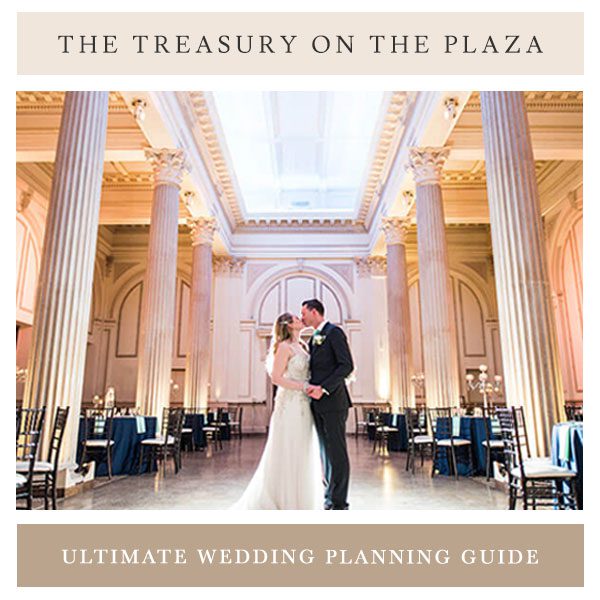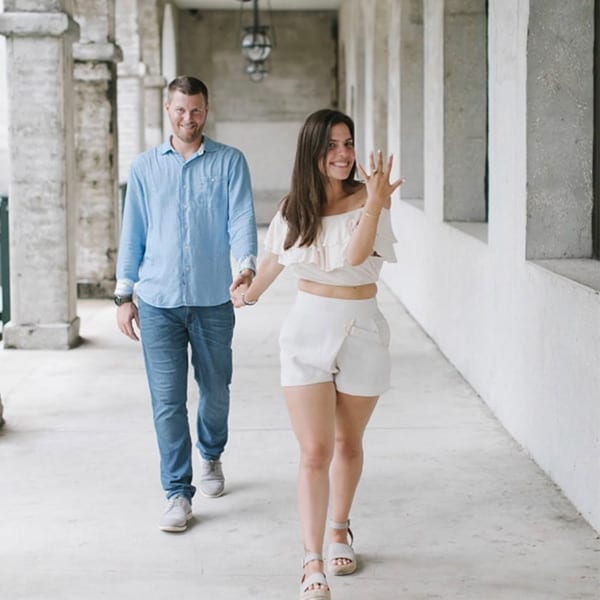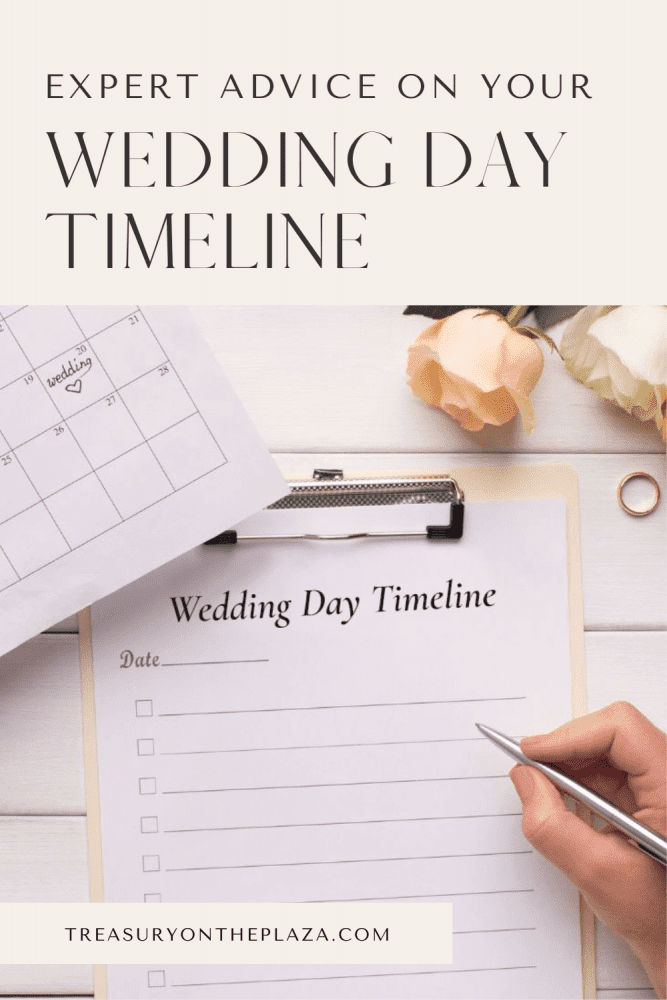You’ve put months, if not years, into planning every perfect detail of your big day. Now you need to make sure everything goes according to plan.
For most couples, this means creating a wedding day timeline that leaves plenty of time for every milestone moment—from the pre-ceremony photos to your big send-off.
But building the ideal timeline isn’t as easy as it looks—especially if you’ve never done this before. So we asked some of our favorite wedding experts for their advice on creating the optimal wedding day timeline.
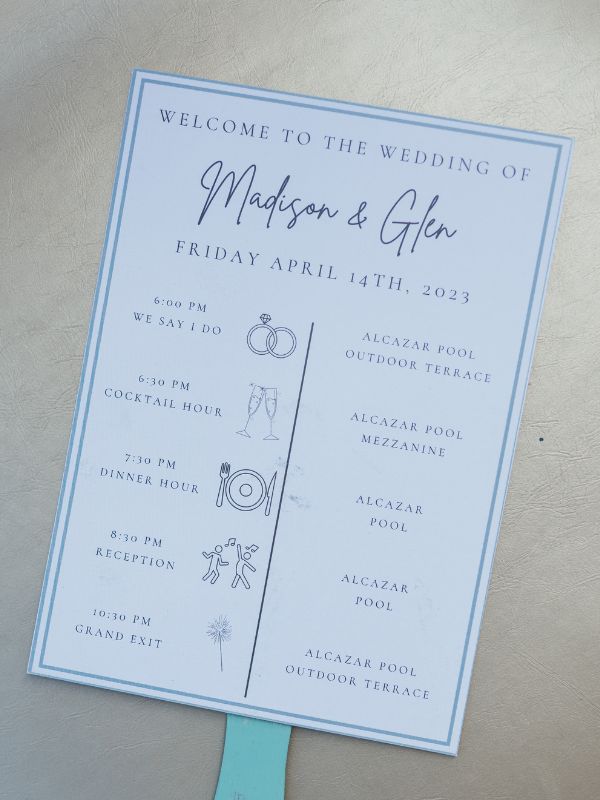
Madison and Glen’s wedding programs featured a timeline of their big day. | Photo: Southern Palms Studio
When should you start creating your wedding day timeline?
Even if you don’t have all the details ironed out yet, it’s best to start sketching out your timeline as soon as possible and discussing it with your vendors.
Your venue can provide a starting point as you start to craft your wedding timeline. Your contract will typically include a venue access time, ceremony start time, and a start and end time for your cocktail hour and reception.
If you’ll be working with a professional wedding coordinator, they will also help with planning out your day. The team of St. Augustine-based wedding planners at Coastal Celebrations says, “An idea of a rough timeline is typically created upon booking. This then becomes a working document [that we] customize with our clients…We typically see this finalized closer to the 30-day mark.”
Other vendors, such as photographers, may want to create a separate timeline. Kristina and Jerico Warner of Walls of Jerico Photography say, “We email out a wedding day questionnaire 3 months before the wedding, […] to create a custom wedding day timeline for our couples based on their needs. We definitely don’t want to wait until the month of the wedding, because the couple has so much going on at that point.”
How does the wedding date impact the timeline?
“The time of year you hold your wedding can make so many decisions about your day!” says Zach Thomas, Owner of Monarch Studios.
For one, couples need to consider what time the sun will be setting on their big day. The hour before sunset (known as “golden hour”) is the ideal time for wedding photographers, as the lighting is warmer and softer than it is at midday.
Couples may also have more or less daylight due to the time of year. Angelita Esparar says:
“The sunset time varies throughout the year. In the winter months, when sunset is early, we plan to do most of the portraits before the ceremony. Summer months allow more daylight, and typically we escape the reception for a few minutes of private bride/ groom portraits.”
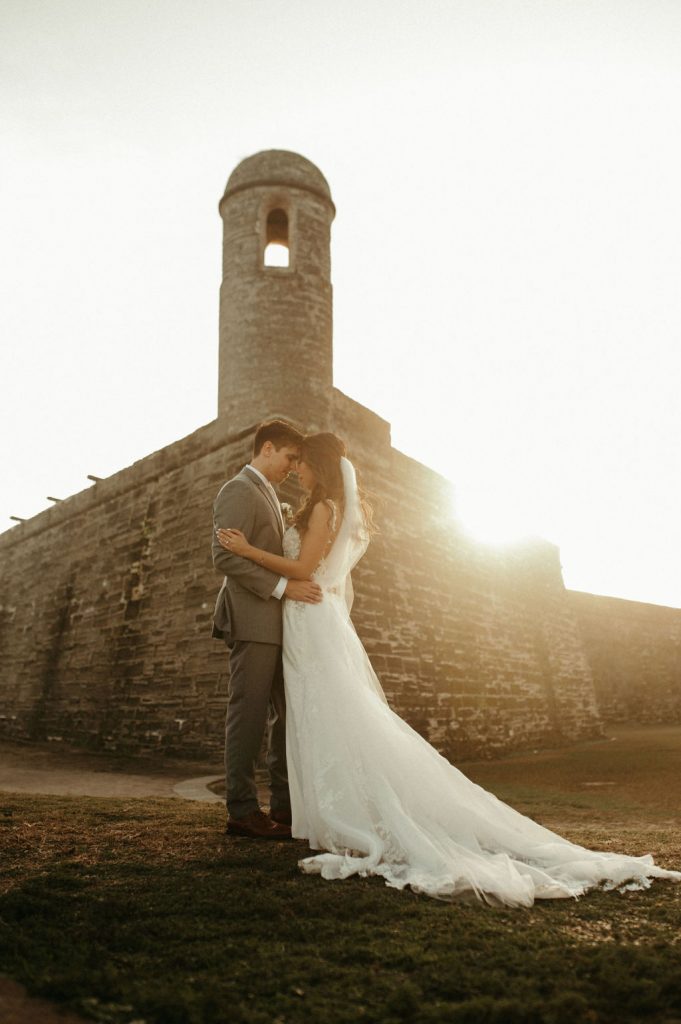
Want those perfect golden hour photos like Ruby and Davis? Make sure to coordinate your wedding portrait times with your photographer to get the best lighting. | Photo: Lunic Visuals
How much time should couples allocate for pre-ceremony activities, such as photos and getting ready?
Let’s face it: your wedding day needs to include a lot more than the ceremony and reception. From hair and makeup to wedding party portraits, there are a lot of pre-ceremony activities that need to be incorporated into your wedding day timeline.
The team at Coastal Celebrations says:
“The amount of time from start to guest arrival [is] approximately 6+ hours. Factors that can affect this might be: how many hair and makeup services do you have? Is the couple doing a first look? Are they doing an off-site ceremony? Are they doing hair and makeup services off-site and, if so, what is that travel time needed?”
Think about everything you need (and want) to do between the completion of getting ready and the ceremony start time. Discuss this list with your photographer and see how much time they typically allow for pre-ceremony photos, as this can vary drastically from photographer to photographer.
For example, photographer Kara Lanteigne allocates between 60-90 minutes for pre-ceremony photos, which includes a first look, wedding party photos, and creative photos. Angelita Esparar prefers to allow between 3-4 hours, “depending on what the bride and groom prefer to do before the ceremony such as first looks, champagne pops, or reading letters.”
When should couples plan photos with each other, their families, and their wedding party?
When it comes to which photos to take when, wedding experts largely agree: whatever works best for you!
“There is no right or wrong way,” says Kara Lanteigne. “Some people want to see each other beforehand, others don’t. If you have a first look, you can accomplish portraits with the wedding party prior. We typically recommend family formals directly after the ceremony because it ensures all family members will be present.”
Again, the time of year should also be considered, so you can get your best shots during golden hour.
Coastal Celebrations says:
“If you are getting married in the fall/winter months, and are working with an earlier sunset, you may need to plan [your] first look to get the majority of your photos done prior to the sun setting. […] Having a first look can help add more photo time in the couples’ day so that they aren’t restricted to getting couple portraits, bridal party and family all done within an hour. While this can really help alleviate the photo time, having a first look does push your day to begin earlier.”
Walls of Jerico shares another perk of doing all of your pictures earlier in the day. “If the couple chooses to do a first look, they can actually do all of their wedding party, family photos, and bride and groom portraits BEFORE the ceremony, which allows the couple to join the full cocktail hour.”
If you want more time to enjoy the day with your guests, this could be a great option!
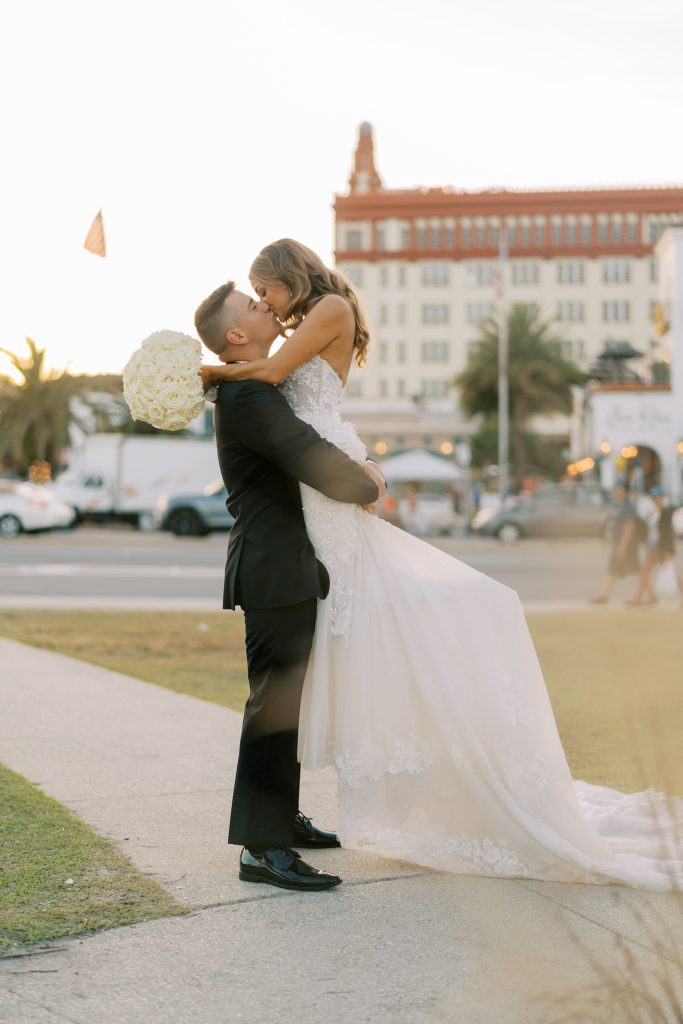
Hanna and Jared opted to take their wedding portraits on the St. Augustine Bayfront. | Photo: Walls of Jerico
What time should couples put on the invitation? How much time should you allocate for guest arrival before starting the ceremony?
No couple wants to walk down the aisle to a half-empty venue or delay their ceremony because they’re waiting for guests to show up.
Proper wedding etiquette is that guests arrive 30 minutes before the ceremony. But Michelle Arias, a wedding planner with Blush By Brandee Gaar, prefers to play it safe. “You should always allocate for your guests to not be on time!”
For this reason, most couples put a time on their invitations that’s 15-30 minutes before they actually plan to start their ceremony.
How much time should couples allow for the wedding ceremony?
“The ideal length for your ceremony is no longer than 30 minutes,” says Michelle Arias. “[But] different traditions that you include in your ceremony can massively impact the length.”
Angelita Esparar agrees that for most ceremonies “twenty to thirty minutes is the sweet spot. Just enough time to capture all the moments.” If your ceremony is too short, you may end up missing out on some of those emotional ceremony photos, or not allowing enough time for your photographer(s) to capture every angle.
If you want to branch out beyond the basic exchanging of vows and rings, be selective about things like speeches, hymns, poems, readings, and/or unity traditions to keep your ceremony short, but sweet.
Some religious or cultural ceremonies tend to be lengthier, so make sure to discuss the ceremony timeline with your officiant. For example, the average Catholic church ceremony can be 45 to 60 minutes. Most Jewish ceremonies are 20 to 30 minutes, while Hindu wedding ceremonies can last one and a half to two hours.
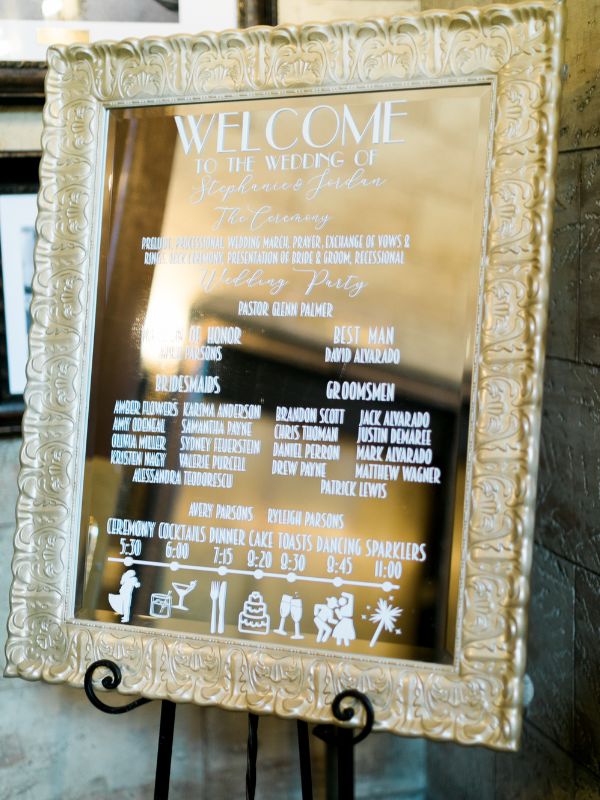
Stephanie and Jordan’s wedding signage shows that they allocated 30 minutes for their wedding ceremony. | Photo: Cailin Smith Photography
Should we schedule a gap between the ceremony and reception?
If you’re having your ceremony and reception in different locations, it can be helpful to schedule a gap in the wedding day timeline to allow guests to travel between venues. But if you’re having both in the same location (such as The Treasury on the Plaza), do you still need that “buffer”?
“Typically an hour [for cocktail hour] between the ceremony and reception is good, depending on the length of the family photo list,” says Esparar.
If you have a cocktail hour in your wedding day timeline, this may be enough, but it’s best to talk to your photographer. They may need to extend this time to fit all of your photos in.
What should couples include in their reception timeline?
For many people—couples and guests alike—the wedding reception is when the party finally starts! However, this doesn’t mean you can throw your wedding day timeline away.
Your timeline should include things like:
- Reception entrances and introductions
- First dance
- Parent dances
- Cake cutting
- Welcome speech
- Dinner blessing
- Toasts
- Garter and bouquet toss
…and any other memorable moments.
However, don’t feel obligated to include something just because it’s “traditional.” Photographer Kara Lanteigne says, “A lot of couples are doing away with some traditional wedding milestones, like cake cutting [and] garter tosses. I think most couples just want it to be more of a party and they don’t want to interrupt the flow of that.”
After you (and your wedding planner) have developed a reception timeline, be sure to discuss it in detail with the emcee of the evening (typically the DJ or band).
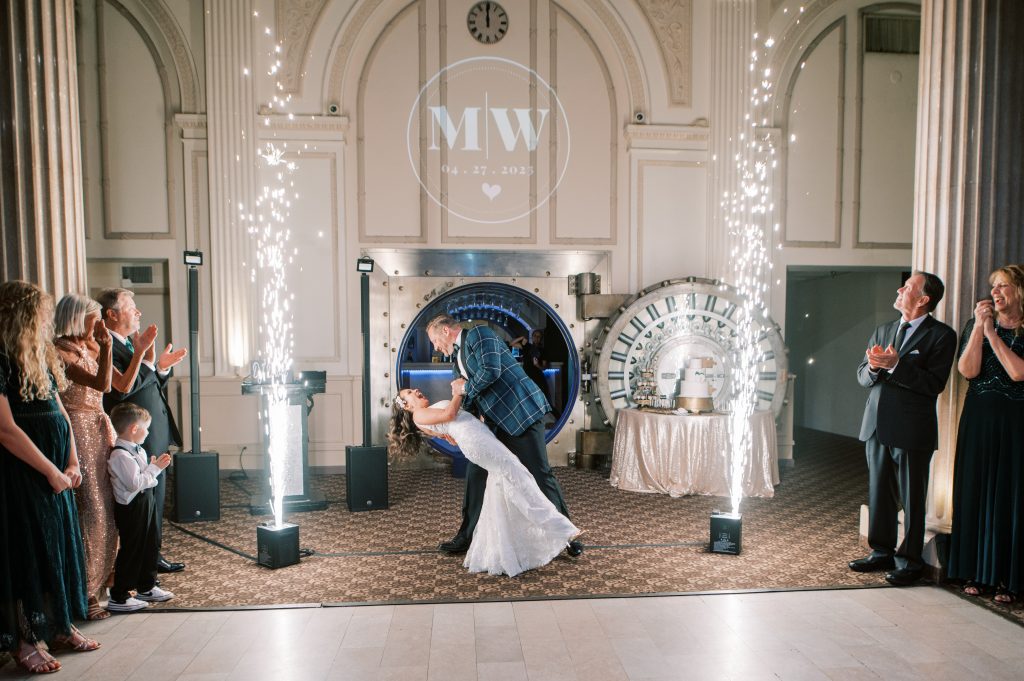
Megan and Wayne made sure to include time for their grand entrance from The Vault at The Treasury on the Plaza in their wedding reception timeline. | Photo: Angelita Esparar Photography
What is the optimal flow for a wedding reception?
Whether your wedding is glamorous or boho, intimate or surrounded by family and friends, every couple wants to see their wedding day flow seamlessly from ceremony to reception.
Coastal Celebrations suggests that couples lean on professional expertise.
“Each venue and event is unique but ultimately they all have the same flow. Based on the elements that you want to include in your timeline, ask your planner or someone from the venue what they see often or the flow of things that work best logistically at that location. Your DJ is also a great resource for asking how to make the entire event flow without it becoming too choppy.”
Kara Lanteigne often sees the following: “It tends to flow well to have everyone seated directly after cocktails, [followed by] a welcome toast from the host, and dinner service. Towards the end of dinner [you’ll do] champagne toasts, dances, and then celebration.”
Katie Leonard, Senior Event Manager at The Treasury Collection shared that “Most of the time, we see the formalities take place after introductions, as the attention in the room is on the couple. We have also seen the parent dances saved for after toasts and cake cutting to kick off open dancing.”
How much time should couples allow for dinner service?
Other than dancing, dinner service is the mainstay of any wedding reception. After all, you’ve spent weeks talking about every detail with your planner, the caterers, and the venue. You don’t want your guests to feel rushed.
An hour is a good starting point, but this time should be adjusted depending on guest count as well as the catering style you chose.
For plated dinners or interactive stations, you may need to plan for a bit more time. Lanteigne recommends at least two hours for 100-200 guests. “Buffet dinner service typically goes a bit faster,” she says. “I would recommend around 1.5-2 hours.”
How should couples plan a perfect end to the evening?
From sparkler exits to luxury cars, wedding send-offs are a great opportunity to showcase your personality and add some whimsy into the day.
Zach Thomas of Monarch Studios says, “Do something…anything. Don’t fizzle, go out with a bang!”
One of Coastal Celebrations’ favorite suggestions? “Plan a last group dance and pick out a song you’ll want to remember! Also, having a formal exit that requires your guests’ participation is a great way to transition your guests to the end of the night without it seeming like they’re being ‘kicked out’.”
Prefer something a little more intimate?
“We highly recommend being intentional about creating as much ‘alone time’ for the couple as possible throughout the day,” says Kristina and Jerico Warner of Walls of Jerico Photography. “One way to do this is doing a private last dance. This allows the couple to slow down and soak in everything that just happened and the fact that they are married!”

Art and Ryan planned a sparker exit that required guest participation to create a fun end to the evening. | Photo: Karen Rainier Photography
It’s Time To Say “I Do!”
Years from now, you’ll look back on this time as being full of excitement, joy, and—most of all—love for your future spouse. Planning out the details of a wedding day timeline will ensure that the two of you can get hitched…without a hitch.
Of course, getting those details right depends a lot on the team you build for yourself.
That’s why it’s crucial that you take the time to research your potential venue, planner, and vendors to make sure you find wedding professionals you can trust.
At The Treasury on the Plaza, our team is devoted to making your wedding as magical and memorable as possible, and our network of industry relationships means you’ll always have access to the best St. Augustine has to offer!
Take a virtual tour of our historic property or schedule an in-person tour today to get a peek at your wedding venue!
Thank you to our wedding pros who shared their expertise!
- Zach Thomas – Monarch Studio
- Angelita Esparar – Angelita Esparar Photography
- Kara Lanteigne – Kara Lanteigne Photography
- The wedding planning team at Coastal Celebrations
- Michelle Arias – Blush By Brandee Garr (Wedding Planning)
- Kristina and Jerico Warner – Walls of Jerico Photography

